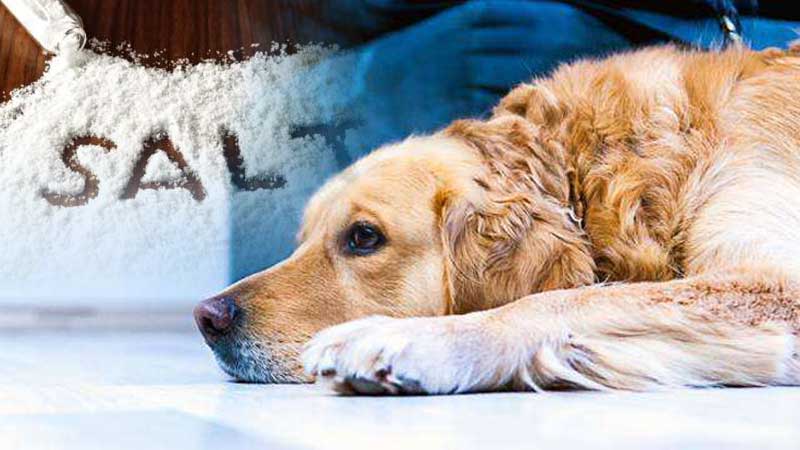- Size
- Smallest
- Small
- Small to Medium
- Medium
- Large
- Giant
- Characteristics
- Smartest
- Hypoallergenic
- Fluffy
- Best Guard
- Best Family
- Best for Kids
- Low Shedding
- Healthiest
- Police Dogs
- Most Calm
- Quietest
- Color
- White
- Black
- Grey
- Brown
- Blue
- Red
- Coat
- Hairless
- Short
- Long
- Origin
- Japan
- China
- Australia
- Germany
- Italy
- United States
- France
- Group
- Hound
- Terrier
- Herding
- Toy
- Working
- Sporting
How Many Grams Of Salt Is Toxic To Dogs?

Too much salt in the human diet can be bad for health, but did you know that excess salt is bad for dogs as well? Our lovable canines sometimes eat things that aren't good for them. Maybe they get into chocolate at Christmas, or grapes during the summer. But usually, the quantity of those items limits how ill our canine friends can get.
The same is not true for salt. In the great outdoors, salt is available in a variety of places in quantities to create salt toxicity that any loving pet owner needs to be aware of.
Dogs need salt. Salt is required for canine body functions. However, the level of salt a dog's body can endure during summer swims in the ocean or licking their paws after an icy walk on salted roads and sidewalks, can be more than their little bodies can handle.
Salt toxicity, or Hypernatremia, depends on a variety of factors, the most important being how much your canine weighs. As a general rule, 1.5 grams of salt per pound is enough to be lethal to your dog.
You might think that's a lot of salt, but if your dog exhibits symptoms of sickness right after a long swim or a walk, it's important to determine if salt toxicity could be the cause.
Water consumption: If your dog is drinking an abnormally large amount of water or not drinking from their bowl at all, these can be signs of salt toxicity especially if coupled with any of these other signs listed below.
Lethargic or walking strangely: If electrolytes drop in your dog due to salt toxicity, it can affect your dog's balance and muscle function. Tremors, depression, high body temperature, and seizures could also be symptoms.
Vomiting or Diarrhea: Vomiting or diarrhea are early signs of salt toxicity, especially after contact with large quantities of salt.
Seizures: Something as dramatic as a seizure is worthy of a trip to the vet, but before the vet runs all kinds of tests, consider if salt toxicity might be a possible cause. During a seizure, it's important to minimize damage both to you and to your dog. Move your dog by the hind legs to a safe spot where they won't injure themselves.
Keep in mind, that during any kind of seizure, your dog may foam at the mouth, have a bowel movement or bite its tongue. Once the seizure has stopped, contact your veterinarian.
So in conclusion, dogs do require salt for their health but there's no need to add salt to their food.
Dog kibble already has the right proportions which are why excess salt may become unhealthy or even lethal. Also, high blood pressure, tremors, or dehydration may be reasons to put your pet on a low-sodium diet. Confer with your veterinarian to see what's the right amount of salt for your dog. And please remember, it’s not just food that can cause salt toxicity.
Look for environmental factors, both man-made or natural, if your dog becomes suddenly ill or exhibits the symptoms of salt toxicity listed above. If uncertain, contact your veterinarian.
References
- [1] ^ Merck Veterinary Manual: Salt Toxicosis in Animals - Toxicology
You May Also Like
 Dog HealthCan humans Get Parvo from Dogs?
Dog HealthCan humans Get Parvo from Dogs? Dog HealthHow Long Does It Take A Dog To Show Signs Of Parvo?
Dog HealthHow Long Does It Take A Dog To Show Signs Of Parvo? Dog HealthVaccines for Dogs: Here's Everything You Need to Know About It
Dog HealthVaccines for Dogs: Here's Everything You Need to Know About It Help & Advice10 Tips for New Dog Owners
Help & Advice10 Tips for New Dog Owners Dog HealthCan I Give Human Amoxicillin To My Dog?
Dog HealthCan I Give Human Amoxicillin To My Dog? Dog HealthWhat Happens If A Dog Eats Amoxicillin?
Dog HealthWhat Happens If A Dog Eats Amoxicillin?